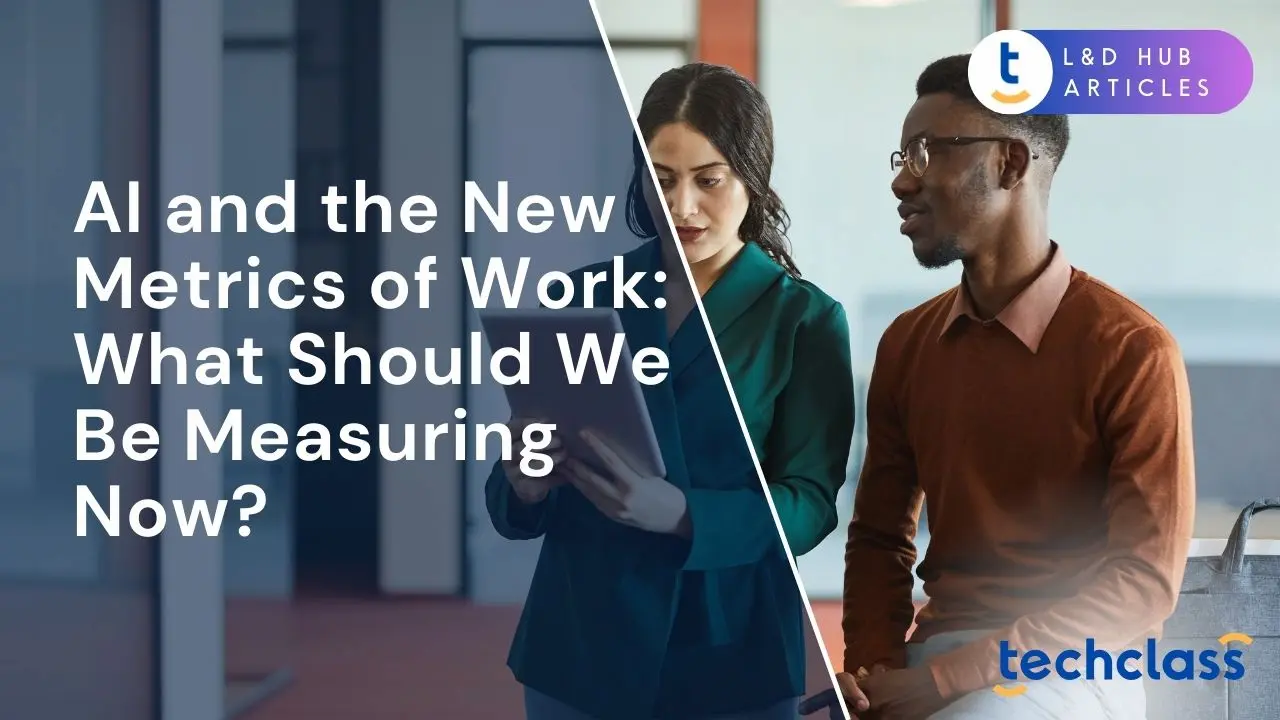
The rise of artificial intelligence in the workplace is fundamentally changing how organizations define and evaluate performance. Traditionally, companies tracked straightforward outputs, hours worked, calls made, and units produced as proxies for productivity. But as AI takes over many routine tasks, these old metrics no longer capture the full picture. Human employees are increasingly focused on creativity, problem-solving, collaboration, and other high-level contributions that are crucial yet harder to quantify. In fact, 74% of organizations in a recent Deloitte survey said it’s “very or critically important” to find better ways to measure worker performance beyond traditional productivity metrics. However, only 17% felt they are very effective at evaluating the true value created by employees beyond basic activity counts. This gap highlights an urgent need to rethink what we measure. Leaders across industries, from HR directors to CISOs and CEOs, must evolve their KPIs to focus on outcomes, innovation, well-being, and ethical use of AI. In the AI era, success isn’t about logging more hours or keystrokes; it’s about capturing the impact and value that human-AI collaboration delivers.
To address this, forward-looking organizations are pivoting to a new set of performance metrics that better reflect today’s work. The following sections explore these emerging metrics, from emphasizing results over busywork to tracking adaptability, collaboration, and even employee well-being. We’ll also discuss how to measure AI’s own impact and ensure metrics are used ethically. These approaches aim to give HR professionals, business leaders, and security officers a clearer, more holistic view of performance in an AI-enhanced workplace.
One of the most important shifts in the AI age is focusing on outcomes instead of just outputs. In practice, this means evaluating employees by the results and impact of their work rather than the volume of tasks or hours logged. With AI automating many low-level and repetitive activities, metrics like the number of calls handled or lines of code written have become less meaningful. As AI becomes central to how organizations operate, effective AI Training programs are essential to help employees adapt and thrive alongside these tools. For example, a customer support agent might offload simple queries to an AI chatbot, so counting calls made would undervalue their real contribution. A better metric is customer issues resolved or customer satisfaction score, which reflects the true outcome. Similarly, a software developer using an AI coding assistant may write fewer lines of code manually, but deliver features faster with fewer bugs. Measuring feature usage rates or defect reduction is far more relevant than raw code commits. In short, what gets measured should be what actually moves the needle for the business.
Emphasizing outcomes helps avoid “productivity theater,” where employees perform for the metrics rather than for meaningful results. When people know they’re judged on real impact, they are less likely to engage in superficial busywork like sending late-night emails or sitting in every meeting just to be seen. Instead, they direct their energy toward high-value activities. Many organizations use goal-setting frameworks like OKRs (Objectives and Key Results) or the Balanced Scorecard to align individual metrics with broader business outcomes. These frameworks ensure that what teams accomplish, not just how much activity they churn out, is front and center. For HR professionals and business leaders, the takeaway is clear: prioritize quality over quantity. Recalibrate performance reviews and dashboards to highlight achievements, impact on key goals, and contributions to business outcomes. By doing so, you encourage employees to work smarter with AI and focus on delivering value, rather than simply looking busy.
In an AI-driven workplace, a premium is placed on employees’ ability to adapt, innovate, and continuously learn. Since machines can rapidly execute routine procedures, human value comes from things machines can’t easily do, creative thinking, novel problem-solving, and learning new skills. It’s crucial to develop metrics that capture these less tangible performance areas. Key indicators for adaptability and innovation include:
By including these kinds of metrics in performance evaluations, organizations send a message that adaptability and innovation are just as important as day-to-day output. A Deloitte study noted that forward-thinking companies are extending performance measures to include quality, innovation, and learning, emphasizing overall value creation by workers rather than just their throughput. Employees who embrace change, learn new skills, and find creative ways to work smarter are the ones who will drive the business forward in the AI era. HR can support this by recognizing and rewarding continuous learners and innovators. Ultimately, measuring adaptability and learning agility helps create a culture where employees aren’t afraid of AI automation, but rather see it as an opportunity to grow and contribute in new ways.
As AI handles more individual tasks, human work is becoming increasingly collaborative. Complex projects today often require teams, cross-functional groups, and knowledge sharing that AI cannot replicate. This means new metrics should illuminate how people connect, communicate, and influence others in the organization. Traditional individual productivity metrics might overlook an employee who, for example, mentors others or acts as the glue between departments. To capture these contributions, companies are adopting measures of collaboration and network performance.
One approach is leveraging tools like Organizational Network Analysis (ONA) to map how information and teamwork flow across the company. ONA data can reveal who your key connectors and communicators are, those individuals who frequently interact with many parts of the organization or who serve as hubs of expertise. For instance, an analysis might show that a certain project manager regularly bridges two otherwise siloed teams. That insight is valuable: if that person left, a critical link between departments could be lost. Metrics can be created around this, such as a “collaboration index” or number of cross-team connections an employee maintains. Some organizations even talk about a “Collaboration Quotient,” identifying employees who are high-impact collaborators, mentors, or information brokers. These are forms of social capital not captured by counting individual tasks completed.
Additionally, more straightforward collaboration metrics can be tracked: for example, participation in team projects, knowledge base contributions, or peer feedback scores on teamwork. If using digital collaboration tools (Slack, Teams, project management software), one might measure responsiveness or contributions within those platforms, but with caution to value quality over quantity of messages. The goal is to recognize those who strengthen the collective output. An employee who shares best practices or helps solve colleagues’ problems might not produce extra widgets, but they raise overall team performance.
For leaders and HR, incorporating collaboration metrics ensures that performance evaluations value “how we win together,” not just individual achievements. It encourages a culture where helping others and breaking down silos is rewarded. This is especially important as enterprises aim for “collaborative intelligence”, humans and AI working in groups effectively. By measuring network influence, organizations can also spot hidden high performers who make others more effective. In the AI era, an employee’s network and teamwork skills can amplify AI’s benefits across many people, so it’s critical to make collaboration count in your metrics.
In the rush to boost productivity with AI, organizations risk burning out their human workforce if they don’t monitor well-being. AI can accelerate work pace and raise expectations, for example, if an AI assistant helps produce work faster, management might shorten deadlines or increase workload. This makes it essential to include employee experience and well-being metrics as part of performance management. Forward-thinking companies treat well-being not as a “soft” HR initiative, but as an operational priority tied to sustainable performance.
Important well-being indicators to measure include:
By monitoring these aspects, companies can create a holistic performance system that asks not just “What did you achieve?” but also “Is the way we’re working sustainable and conducive to growth?”. There’s mounting evidence that well-being and performance are intertwined. In one experiment, Hitachi implemented a human-centric performance approach and saw a 33% increase in workers’ psychological capital (e.g. resilience and optimism) alongside a 10% rise in profits. Sales per hour improved by over 15% in their call centers, demonstrating that a happier, less stressed workforce drove better business outcomes. This case and others underscore that caring for employees’ mental and physical health isn’t at odds with productivity, it actually unlocks it.
For enterprise leaders, especially HR and people analytics teams, the message is to treat employee well-being metrics (workload balance, burnout signals, engagement levels) as core KPIs. Regularly review these alongside financial and operational metrics. By catching issues early, before they result in burnout or turnover, organizations can adjust course (hiring relief staff, changing policies, etc.). Ultimately, measuring well-being reinforces a culture where employees are empowered to do their best work without sacrificing their health and happiness, which is critical for sustainable success in the AI-enhanced workplace.
With AI now permeating many job functions, organizations should explicitly measure how AI is being adopted and the impact it’s having on work output. This is a new dimension of performance analytics: understanding the return on investment from AI tools and identifying where human-AI collaboration is (or isn’t) working. By tracking AI adoption metrics, business owners and HR leaders can gauge their company’s progress in the AI journey and allocate support or training where needed.
Some useful metrics in this category include:
By incorporating AI adoption and impact metrics, enterprises make AI’s presence in the workplace visible and manageable. Rather than assuming AI is helping (or fearing it isn’t), leaders get data on where it’s working and where to optimize. HR and department heads can identify teams that lag in AI use and target them for training or tools, ensuring no group is left behind. Conversely, teams leading in AI-driven productivity can be studied as models for others. Importantly, measuring AI impact also reinforces an outcome focus: it’s not about using AI for AI’s sake, but using it to achieve better results. This mindset steers organizations to deploy AI in ways that truly augment human performance. Over time, as AI becomes as common as computers or the internet at work, these metrics will simply fold into regular performance tracking. But in this transition phase, they are crucial for guiding AI strategy and maximizing the human-AI partnership.
As organizations gather more data on employees and leverage AI in performance management, maintaining trust and ethics is paramount. HR professionals and CISOs, in particular, must ensure that new metrics and AI tools don’t cross the line into surveillance or bias. It’s all too easy for well-intentioned analytics to erode employee privacy or treat people unfairly if not handled carefully. Therefore, a modern approach to metrics includes not just what we measure, but how we measure it, with transparency, consent, and fairness.
One cautionary example came when Microsoft introduced a “Productivity Score” feature in its 365 software that allowed managers to see detailed activity data per individual (emails sent, meetings attended, etc.). The tool was meant to highlight technology usage, but it sparked immediate backlash as a form of workplace surveillance. Privacy advocates and employees alike criticized the idea of bosses drilling down into each person’s digital activity. Microsoft quickly backtracked and changed the feature to aggregate data rather than personal metrics. The lesson is clear: monitoring individual employees too closely can undermine morale and trust. Nobody wants to feel like a cog under a microscope, even if the goal is improved productivity.
To avoid such pitfalls, leading organizations are embracing privacy-conscious measurement. This means focusing on aggregate, anonymized metrics at the team or organizational level, rather than singling out individuals. For example, you might report that “Team A averaged 10% more focus time this quarter” or “Organization-wide AI tool adoption is 60%,” without naming who did how much. This provides useful insights while respecting individual privacy. It’s also important to be transparent with employees about what data is collected and why. Under regulations like GDPR and California’s CCPA, employees have a right to know and even opt out of certain data collection. Even if not legally required in all jurisdictions, openness builds trust. Explain the purpose of any new monitoring, e.g. “We are measuring after-hours logins across the company to identify burnout risks and encourage better balance.” When workers see that metrics are used to help them (improving workflows, allocating resources) rather than punish them, they are more likely to support these initiatives.
Another critical aspect is ensuring fairness and avoiding bias, especially if using AI to evaluate performance data. AI models that flag “high performers” or recommend promotions can inadvertently reinforce biases present in historical data. For instance, if an algorithm rewards working extra long hours, it might disadvantage those with caregiving responsibilities who leave on time, not because they’re less productive, but because of biased criteria. Companies should audit any AI-driven metrics or decision systems for bias and make adjustments as needed (e.g. ensuring a performance score doesn’t correlate unduly with demographic factors). Incorporating metrics for ethical AI use is a novel but increasingly important idea. For example, tracking the diversity of those recognized by AI-driven evaluations or monitoring for any anomalous patterns in how different groups are rated can surface issues. Some organizations establish an AI ethics committee or use third-party bias detection tools to regularly review their algorithms. As a rule, human oversight should remain in the loop for significant decisions, algorithms can assist, but managers must apply judgment and context.
Finally, consider metrics around data security and compliance in this arena, something CISOs will be attuned to. If implementing a new employee analytics platform, measure compliance with privacy training (what percentage of managers and analysts have been trained on proper use of employee data). You can also track data access, ensuring only authorized persons view sensitive metrics. Any breaches of data governance (like someone attempting to re-identify anonymized data) should be logged and addressed. These steps underscore a commitment that while we want to leverage data and AI for performance insights, we will not compromise individual rights and security.
In summary, responsible use of AI and analytics is itself a metric of organizational maturity. Leaders need to champion a culture where the pursuit of performance improvement never eclipses respect for people. By being transparent, obtaining consent where appropriate, and auditing for fairness, companies can maintain the trust of their workforce. This trust is not just a “nice to have”, it directly impacts the success of any new metric or AI initiative. When employees see that data is used ethically, they are more likely to participate fully (for instance, honestly answering engagement surveys or embracing new AI tools), which in turn leads to better data and outcomes. In the AI era, privacy and ethics have become key performance indicators for leadership.
As AI reshapes work, it’s tempting to measure everything that technology makes measurable. But the goal of modern performance metrics isn’t to drown in data, it’s to focus on better data. We should measure what truly drives innovation, engagement, and business results, not just what’s easiest to count. The new metrics of work we’ve discussed, outcomes achieved, adaptability shown, collaboration fostered, well-being maintained, and value gained from AI, all share a common theme. They put people at the center. The future of work is not just AI-enabled, it’s human-centered.
By embracing human-centric metrics, organizations signal that technology’s role is to empower employees, not replace or dehumanize them. Instead of micromanaging with dashboards and scores, the emphasis shifts from static outputs to dynamic outcomes, from routine execution to creative collaboration. This shift is crucial at the awareness stage for leaders: it frames AI as a tool to elevate human potential rather than a tracking device for squeezing more work out. HR professionals can lead the way by updating performance review criteria and HRIS analytics to include these new measures. Business owners and executives can set the tone by asking for reports on things like innovation rates, team connectivity, and employee wellness alongside the usual financial KPIs. And CISOs or compliance leaders can ensure that as we get more data-driven, we also set policies that protect privacy and fairness, reinforcing a culture of trust.
In practice, moving to new metrics will be an iterative journey. Start by piloting some of these measures in a department or two. Learn how to collect the data (perhaps using new digital tools or surveys), and evaluate how it correlates with success. You might find, for example, that teams with higher collaboration scores also deliver projects faster, or those with better well-being metrics have lower turnover. These insights will help refine which metrics truly matter for your organization. Over time, we predict a convergence: companies that get metrics right will attract and retain talent who appreciate being valued for the right things. They’ll also be more agile, innovative, and resilient in a world where AI is ubiquitous.
In conclusion, AI is changing work, and we must change how we measure work accordingly. By focusing on outcomes, adaptability, collaboration, well-being, and ethical AI use, leaders can obtain a richer, more accurate gauge of performance. More importantly, they send a message to their people about what the organization values. In the end, what you measure is what you’ll get. Measure outputs, and you’ll get outputs. Measure growth, impact, and people’s well-being, and you’ll get a thriving, future-ready workforce poised to excel alongside AI.
Traditional metrics like hours worked or tasks completed often miss the true value employees create when AI handles routine tasks. Today, performance needs to focus on outcomes, innovation, and collaboration rather than sheer output.
Examples include customer satisfaction scores, issues resolved, feature usage rates, and defect reduction. These metrics measure real business impact rather than activity volume.
They can track learning agility through courses completed, certifications earned, and AI integration into workflows, as well as innovation indicators like implemented ideas or successful new projects.
Well-being metrics like work-life balance, burnout risk, engagement scores, and learning participation help ensure sustainable productivity and prevent turnover or burnout.
By using anonymized, aggregated data, being transparent about data collection, auditing AI for bias, and maintaining human oversight in performance evaluations.


